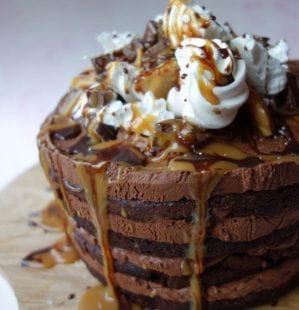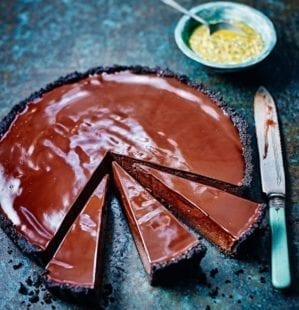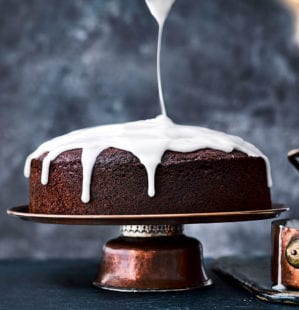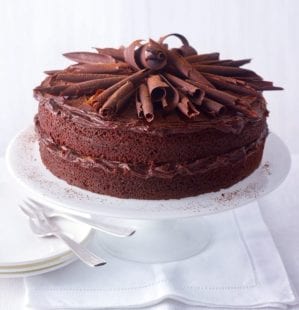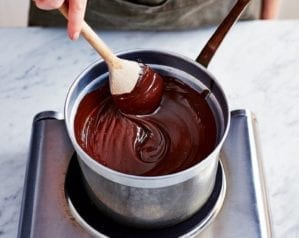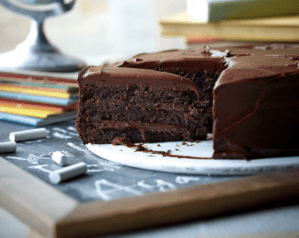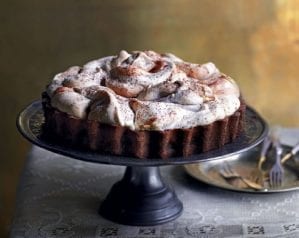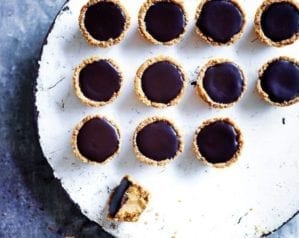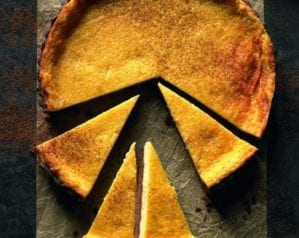
Dark chocolate orange mousse cake
- Published: 10 Feb 15
- Updated: 18 Mar 24
Keep this dark chocolate orange mousse cake recipe in your repertoire for the best showoff, show-stopping chocolate cake.
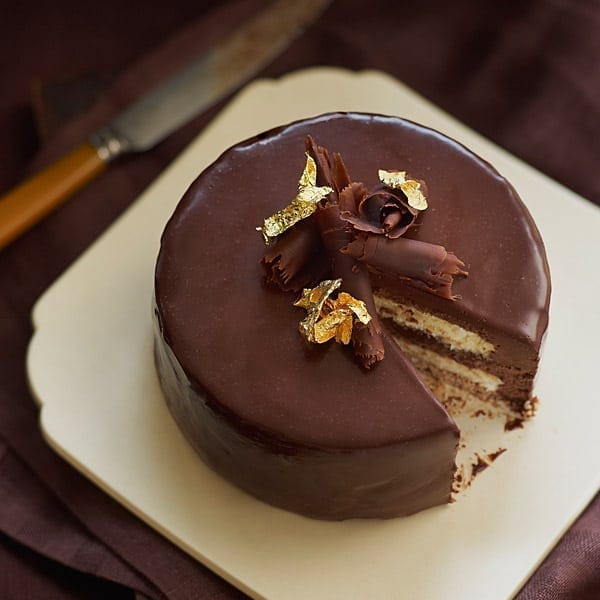
-
Hands-on time 2 hours, cooking time 30 min, plus cooling and chilling
Ingredients
For the genoese sponge
- 2 large free-range egg whites
- 88g golden caster sugar
- 6 free-range egg yolks
- 88g plain flour, sifted
For the wafer biscuit
- 65g milk chocolate (minimum 30% cocoa solids)
- 60g cornflakes
- 35g ground almonds, whizzed with 15g dark brown sugar and 1 tbsp vegetable oil
For the chocolate mousse
- 230g dark chocolate, finely chopped (minimum 70% cocoa solids. William uses Amadei Toscano 70%)
- 6 large free-range egg yolks
- 50g caster sugar
- 30ml water
- 250ml whipping cream
For the Grand Marnier syrup
- 45g caster sugar
- 45g water
- 40ml Grand Marnier orange liqueur
- ¼ vanilla pod
For the chocolate glaçage
- 175ml whipping cream
- 33g caster sugar
- 26g liquid glucose (available in the baking aisle of large supermarkets or online)
- 100g dark chocolate (minimum 70% cocoa solids), finely chopped
To assemble
- 3 tbsp sweet orange marmalade (we used Robinson’s Golden Shred)
- Chocolate curls
- Edible gold leaf (available online from squires-shop.com)
Method
- Preheat the oven to 180°C/fan160°C/gas 4 and line a 25cm x 33cm baking tray with baking paper. Make the sponge. With an electric mixer, whisk the egg whites until they form stiff peaks, then gradually whisk in the sugar, until you have a stiff meringue.
- With the mixer going, add the egg yolks, one by one, then gently fold in the flour until you have a smooth, mousse-like mixture. Spread onto the baking tray, level the top and bake for 18-20 minutes, until golden. Turn out and leave to cool on a wire rack.
- For the wafer biscuit, finely chop the chocolate and melt in a heatproof bowl set over a pan of simmering water (don’t let the water touch the bottom of the bowl). Line a baking sheet with baking paper, then whizz the cornflakes with the almond and sugar mixture. When the chocolate has melted, stir through the almond and cornflake mixture. Spread in a thin layer on the baking sheet, then chill in the fridge to set.
- To make the syrup, put the sugar and water in a saucepan with the scraped-out seeds from the vanilla pod. Bring to a boil, melt the sugar, then stir in the Grand Marnier and set aside.
- Place a 14cm metal cake ring on a baking paper-lined tray. Cut the wafer biscuit into a 13cm disc and place inside the ring. (The wafer leftovers are delicious for snacking or crumbled over ice cream.
- Cut out 2 x 12cm discs from the genoese sponge using a small saucer as a template. Liberally brush one with the Grand Marnier syrup (about 2-3 tbsp), then place it on top of the wafer base. Return to the fridge to chill.
- To make the chocolate mousse, melt the chocolate gently (as in step 3 above), then remove from the heat and allow to cool slightly.
- Meanwhile, put the sugar and water in a small saucepan and bring to the boil. Cook until it reaches 120°C (firm ball stage) on a sugar thermometer. Keep an eye on it – it will heat slowly at first, then speed up dramatically. Take it off the heat when it reaches 118°C as it keeps warming up for a bit. Meanwhile, while the sugar and water is bubbling, whisk the egg yolks in a stand mixer until pale and fluffy. When the sugar syrup is the right temperature, with the whisks going, pour the syrup down the side of the mixer bowl in a thin, steady stream until it’s all incorporated. Make sure you don’t let the hot syrup touch the beaters as you pour (as it might flick the hot syrup out of the bowl). Continue to whisk until the mixture has cooled.
- In a separate bowl, whip the cream until it forms soft peaks, then fold it into the egg mixture. Carefully mix one-third of this mixture into the melted chocolate, then fold in the remainder. Don’t worry if it curdles at first – give it a whisk and it should come back together as you add more of the cream mix.
- Spread a layer of the chocolate mousse on top of the sponge and down the sides to fill the gap between the sponge and the cake ring. Spoon the marmalade over the mousse, leaving a 1cm border around the outside. Brush the second sponge with the Grand Marnier syrup, then gently place this on top of the marmalade.
- Carefully spread the rest of the mousse over the sponge and around the sides, making sure there are no air pockets, and fill the cake ring, levelling the top. Chill in the freezer for 2-3 hours.
- Unmould the cake by running a chef’s blow torch around the outside of the ring, until you can see the edge of the mousse just begin to melt. Slide the mould off carefully, then put the cake into the fridge for 10 minutes while you make the glaçage.
- For the glaçage, put the cream, sugar and liquid glucose in a heavy-based saucepan and bring to the boil. In a mixing bowl, gradually add the hot cream mixture to the finely chopped chocolate, mixing continuously to form an emulsion. When the glaçage is smooth and glossy, use immediately.
- Place the cake on a wire rack set over a tray to catch the excess icing. Pour the glaçage carefully over the cake, starting at the edges and working your way to the centre, smoothing it with a palette knife to make sure it’s even. Once completely coated, put back in the fridge to set for half an hour, then remove and leave in a cool place to defrost for a couple of hours.
- Decorate with chocolate curls and edible gold leaf before serving.
Nutrition
- Calories
- 808kcals
- Fat
- 47.7g (24.6g saturated)
- Protein
- 11.4g
- Carbohydrates
- 80g (66.2g sugars)
- Fibre
- 2.2g
- Salt
- 0.4g
delicious. tips
This recipe is a labour of love, but the result is something you might find in a Parisian patisserie. Don’t be tempted to deviate from the recipe, though – it needs to be followed to the letter! And make sure you’re fully prepped before you begin to assemble.
Glaçage is a type of shiny ganache used in classic patisserie to give a glossy, professional-looking finish. For best results, you’ll need a sugar thermometer, a stand mixer and a chef’s blowtorch. A genoese sponge is one made without a raising agent such as baking powder. The whisked in air gives the sponge its lightness.
Buy ingredients online
Rate & review
Rate
Reviews
Subscribe to our magazine
Food stories, skills and tested recipes, straight to your door... Enjoy 5 issues for just £5 with our special introductory offer.
Subscribe
Unleash your inner chef
Looking for inspiration? Receive the latest recipes with our newsletter

